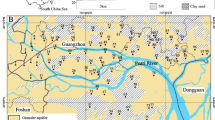Abstract
A logistic regression model for the probability of arsenic exceeding the drinking water guidelines (10 μg/L) in bedrock groundwater was developed for a selected county in Korea, where arsenic occurrence and release reactions have been investigated. Arsenic was enriched naturally by the oxidation of sulfide minerals in metasedimentary rocks and mineralized zones, and due to high mobility in alkaline pH conditions, concentrations were high in groundwater of the county. When considering these reactions of arsenic release and water quality characteristics, several geological and geochemical factors were selected as influencing variables in the model. In the final logistic regression model, geological units of limestone and metasedimentary rocks, the concentrations of nitrate and sulfate, and distances to closed mines and adjacent granite were retained as statistically significant variables. Predicted areas of high probability agreed well with known spatial contamination patterns in the county. The model was also applied to an adjacent county, where the groundwater has not previously been tested for the presence of arsenic, and a probability map for arsenic contamination was then produced. Through the analysis of arsenic concentrations at the wells of high probability, it was determined that the applied model accurately indicated the arsenic contamination of groundwater. The logistic regression approach of this study can be applied to predict arsenic contamination in areas of similar geological and geochemical conditions to the county used in this model.









Similar content being viewed by others
References
Ahn JS (2012) Geochemical occurrence of arsenic and fluoride in bedrock groundwater: a case study in Geumsan County, Korea. Environ Geochem Health 34:43–54
Ahn JS, Ko KS, Chon CM (2007) Arsenic occurrence in groundwater of Korea. Jour Korean Soc Soil Ground Environ 12:64–72 (in Korean)
Amini M, Abbaspour KC, Berg M, Winkel L, Hug SJ, Hoehn E, Yang H, Johnson CA (2008a) Statistical modeling of global geogenic arsenic contamination in groundwater. Environ Sci Technol 42:3669–3675
Amini M, Mueller K, Abbaspour KC, Rosenberg T, Afyuni M, Møller KN, Sarr M, Johnson CA (2008b) Statistical modeling of global geogenic fluoride contamination in groundwaters. Environ Sci Technol 42:3662–3668
Ayotte JD, Nolan BT, Nucklos JR, Cantor KP, Robinson GR, Baris D, Hayes L, Karagas M, Bress W, Silverman DT, Lubin JH (2006) Modeling the probability of arsenic in groundwater in New England as a tool for exposure assessment. Environ Sci Technol 40:3578–3585
Hosmer DW, Lemeshow S (2000) Applied logistic regression, 2nd edn. Wiley, New York, p 375
Hossain F, Hill J, Bagtzoglou AC (2007) Geostatistically based management of arsenic contaminated ground water in shallow wells of Bangladesh. Water Resour Manage 21:1245–1261
Keshavarzi B, Moore F, Rastmanesh F, Kermani M (2012) Arsenic in the Muteh gold mining district, Isfahan, Iran. Environ Earth Sci 67:959–970
KIGAM (1977) Geological map of Korea, Boeun sheet 1:50000. Korea Institute of Geoscience and Mineral Resources
KOWACO (2007) Report on the basic groundwater survey of Boeun County. Korea Water Corporation, 11-1500000-002201-01, p 148
Lee JJ, Jang CS, Wang SW, Liu CW (2007) Evaluation of potential health risk of arsenic-affected groundwater using indicator kriging and dose response model. Sci Total Environ 384:151–162
Li Z, Hong H, Jean JS, Koski AJ, Liu CC, Reza S, Randolph JJ, Kurdas SR, Friend JH, Antinucci SJ (2011) Characterization on arsenic sorption and mobility of the sediments of Chia-Nan Plain, where blackfoot disease occurred. Environ Earth Sci 64:823–831
MIRECO (2005) A survey of mining hazards in the abandoned metal mines. Mine Reclamation Corporation, Technical Report 05-02, p 371
Nolan BT (2001) Relating nitrogen sources and aquifer susceptibility to nitrate in shallow ground waters of the United States. Ground Water 39:290–299
Nolan BT, Hitt KJ (2006) Vulnerability of shallow groundwater and drinking-water wells to nitrate in the United States. Environ Sci Technol 40:7834–7840
Nolan BT, Hitt KJ, Ruddy BC (2002) Probability of nitrate contamination of recently recharged groundwaters in the conterminous United States. Environ Sci Technol 36:2138–2145
Petrini R, Slejko F, Lutman A, Pison S, Franceschini G, Zini L, Italiano F, Galic A (2011) Natural arsenic contamination in waters from the Pesariis village, NE Italy. Environ Earth Sci 62:481–491
Smith AH, Lingas EO, Rahman M (2000) Contamination of drinking-water by arsenic in Bangladesh: a public health emergency. Bull World Health Organ 78:1093–1102
Twarakavi NKC, Kaluarachchi JJ (2005) Aquifer vulnerability assessment to heavy metals using ordinal logistic regression. Ground Water 43:200–214
Winkel L, Berg M, Amini M, Hug SJ, Johnson CA (2008) Predicting groundwater arsenic contamination in Southeast Asia from surface parameters. Nat Geosci 1:536–542
Acknowledgments
This research was supported by the Basic Research Project (12-3212) of the Korea Institute of Geoscience and Mineral Resources (KIGAM) funded by the Ministry of Knowledge Economy of Korea.
Author information
Authors and Affiliations
Corresponding author
Rights and permissions
About this article
Cite this article
Ahn, J.S., Cho, YC. Predicting natural arsenic contamination of bedrock groundwater for a local region in Korea and its application. Environ Earth Sci 68, 2123–2132 (2013). https://doi.org/10.1007/s12665-012-2179-9
Received:
Accepted:
Published:
Issue Date:
DOI: https://doi.org/10.1007/s12665-012-2179-9




